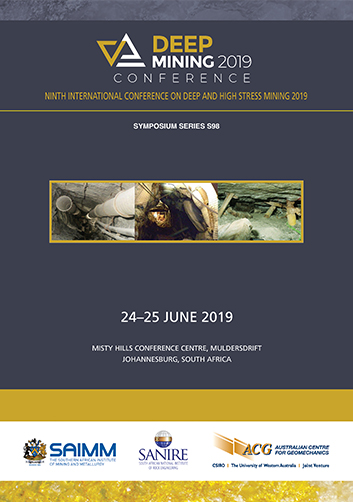Stoping sequence optimisation at Eleonore Mine based on stress analysis through horizon scale numerical modelling

|
Authors: Bouzeran, L; Pierce,M; Jalbout, A; Ruest, M |
DOI https://doi.org/10.36487/ACG_rep/1952_20_Bouzeran
Cite As:
Bouzeran, L, Pierce,M, Jalbout, A & Ruest, M 2019, 'Stoping sequence optimisation at Eleonore Mine based on stress analysis through horizon scale numerical modelling', in W Joughin (ed.), Deep Mining 2019: Proceedings of the Ninth International Conference on Deep and High Stress Mining, The Southern African Institute of Mining and Metallurgy, Johannesburg, pp. 253-266, https://doi.org/10.36487/ACG_rep/1952_20_Bouzeran
Abstract:
The orebody at Eleonore Mine (Eleonore) consists of multiple lenses of narrow thickness. Owing to ground stability issues, the capacity of the support was increased and the mine sequence was changed successfully in 2016. In 2018, mine-scale geomechanical numerical analyses were conducted in the continuum code FLAC3D to better understand the conditions leading to these improvements and further optimise the sequence. Locations of falls of ground and damage, blast hole performance and a micro-seismic database were used to calibrate the model, and different future mining sequences were analysed. The models helped demonstrate that persistent shallow dipping joints subject to high horizontal stress put a lot of demand on bolts in the back of excavation; they are likely to be the main source of energy release as they are sheared peripheral to the top and bottom of the stopes. The narrow-mined width and good rock strength involve limited stope interaction, resulting in highly stressed remnant stopes and limited impact of the sequence.
References:
Clark, I. H. 2006. Simulation of Rockmass Strength Using Ubiquitous Joints. Proceedings of the 4th International Symposium on Numerical Modelling in Geomechanics. Hart R. and Varona P. (eds). Itasca Consulting Group, Inc. Paper No. 08-07.
Corthésy, R. andM.H. Leite. 2017. Mesures Des Contraintes In-Situ Mine Éléonore, rapport préliminaire. Polytechnique Montréal, Bureau de la recherche et centre de développement technologique.
Guido, S. 2018. Seismic cluster best-fit planes VS UG mapping. Internal email-communication from GoldCorp to Itasca, January 2018.
Hoek E., Brown E. T. 1980. Underground Excavations in Rock. The Institution of Mining and Metallurgy, London, 93–101.
Hoek, E., C. Carranza-Torres and B. Corkum. 2002. “Hoek-Brown Failure Criterion - 2002 Edition,” in NARMS-TAC 2002: Mining and Tunnelling Innovation and Opportunity, Vol. 1, pp. 267-273. R. Hammah et al, Eds. Toronto: University of Toronto Press.
Itasca Consulting Group, Inc. 2017. FLAC3D — Fast Lagrangian Analysis of Continua in 3 Dimensions, Version 6.0. Minneapolis: Itasca.
Oke, J., Kalenchuk K. 2017. MDEng Factual Report #1015-F1704-01: Geotechnical Mapping and Site Characterization. Prepared for Goldcorp Inc., Eleonore Mine by MDeng.
Pierce, M. 2013. Numerical Modelling of Rock Mass Weakening, Bulking and Softening Associated with Cave Mining. ARMA e-newsletter. ARMA publications committee, spring 2013.
Yong, S. 2014. “In Situ Stress, Determination, Éléonore Project, Quebec,” MIRARCO, Geomechanics Research Centre.
© Copyright 2025, Australian Centre for Geomechanics (ACG), The University of Western Australia. All rights reserved.
View copyright/legal information
Please direct any queries or error reports to repository-acg@uwa.edu.au
View copyright/legal information
Please direct any queries or error reports to repository-acg@uwa.edu.au